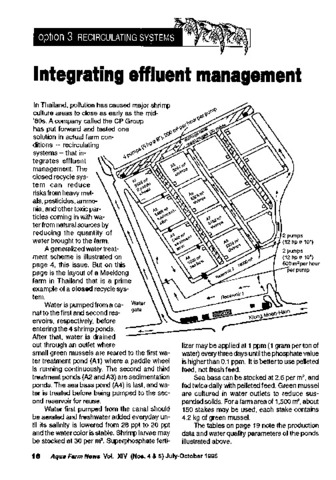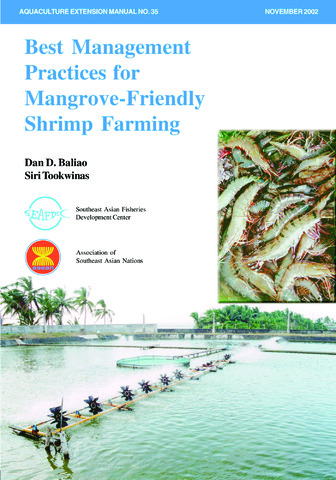| dc.contributor.author | Alcañices, Marilyn M. | |
| dc.contributor.author | Pagulayan, Roberto C. | |
| dc.contributor.author | Mamaril, Augustus C. | |
| dc.date.accessioned | 2012-01-19T11:05:04Z | |
| dc.date.available | 2012-01-19T11:05:04Z | |
| dc.date.issued | 2001 | |
| dc.identifier.citation | Alcañices, M. M., Pagulayan, R. C., & Mamaril, A. C. (2001). Impact assessment of cage culture in Lake Taal, Philippines ((Abstract only). In C. B. Santiago, M. L. Cuvin-Aralar, & Z. U. Basiao (Eds.), Conservation and Ecological Management of
Philippine Lakes in Relation to Fisheries and Aquaculture (p.153). Tigbauan, Iloilo, Philippines: Aquaculture Department, Southeast Asian Fisheries Development Center; Los Baños, Laguna, Philippines: Philippine Council for Aquatic and Marine Research and Development (PCAMRD), Department of Science and Technology; Quezon City, Philippines: Bureau of Fisheries and Aquatic Resources (BFAR), Department of Agriculture, Quezon City, Philippines. | en |
| dc.identifier.isbn | 9718511539 | |
| dc.identifier.uri | http://hdl.handle.net/10862/836 | |
| dc.description | Abstract only. | en |
| dc.description.abstract | The environmental impact of cage culture on water quality of Lake Taal was assessed from March 1996 through February 1997. Three stations were considered namely: Balas, which serves as station 1 (non-cage area) and Sampaloc and Laurel, stations 2 and 3 (cage areas), respectively. Monthly water samples with two replicates were collected using a van Dorn sampler at 0, 5, 10 and 15-m depths in all stations. Below surface water from the inside of the cages was also collected. Water temperature, water transparency, pH, and conductivity were determined in situ. Dissolved oxygen, chloride, NO3, NH3, PO4, and total P were analyzed in the laboratory. Phytoplankton density and algal biomass (through cholorophyll a) and primary productivity indices were determined with the light-and-dark bottle method.
Of the water quality parameters, conductivity and DO had significant differences between non-cage and cage areas. Conductivity gave significant difference (P<0.01) between control and cage area during the wet season. Highest conductivity value (2100 µ S/cm) was observed in station 3. Mean values of DO gave significant differences (P<0.05) in the different stations throughout the study period. A decrease of DO to 2.5 mg/1 was observed below 10-m depth around the cage areas. Analysis indicates that cage culture leads to oxygen depletion in the water column. The presence of cage structures decreased the flow rate resulting to weak circulation. The reduced water circulation in effect decreased the supply of oxygen and removal of toxic waste metabolites from the vicinity of the fish farm, and reduced the supply of plankton. These results suggest that the impact of cage culture in Lake Taal is minor but can alter the lake ecosystem if not properly managed. Zoning and continuous water quality monitoring are needed. | en |
| dc.language.iso | en | en |
| dc.publisher | Aquaculture Department, Southeast Asian Fisheries Development Center | en |
| dc.publisher | Philippine Council for Aquatic and Marine Research and Development (PCAMRD), Department of Science and Technology | en |
| dc.publisher | Bureau of Fisheries and Aquatic Resources | en |
| dc.subject | Philippines, Luzon I., Batangas, Taal L. | en |
| dc.title | Impact assessment of cage culture in Lake Taal, Philippines | en |
| dc.type | Conference paper | en |
| dc.citation.spage | 153 | |
| dc.subject.asfa | cage culture | en |
| dc.subject.asfa | environmental assessment | en |
| dc.subject.asfa | environmental impact | en |
| dc.subject.asfa | fish culture | en |
| dc.subject.asfa | freshwater aquaculture | en |
| dc.subject.asfa | freshwater lakes | en |
| dc.subject.asfa | oxygen depletion | en |
| dc.subject.asfa | plankton surveys | en |
| dc.subject.asfa | water properties | en |
| dc.subject.asfa | water quality | en |
| dc.subject.asfa | water sampling | en |
| dc.citation.conferenceTitle | Conservation and Ecological Management of Philippine Lakes in Relation to Fisheries and Aquaculture: Proceedings of the National Seminar-Workshop held on October 21-23, 1997, INNOTECH, Commonwealth Ave., Diliman, Quezon City, Philippines | en |



